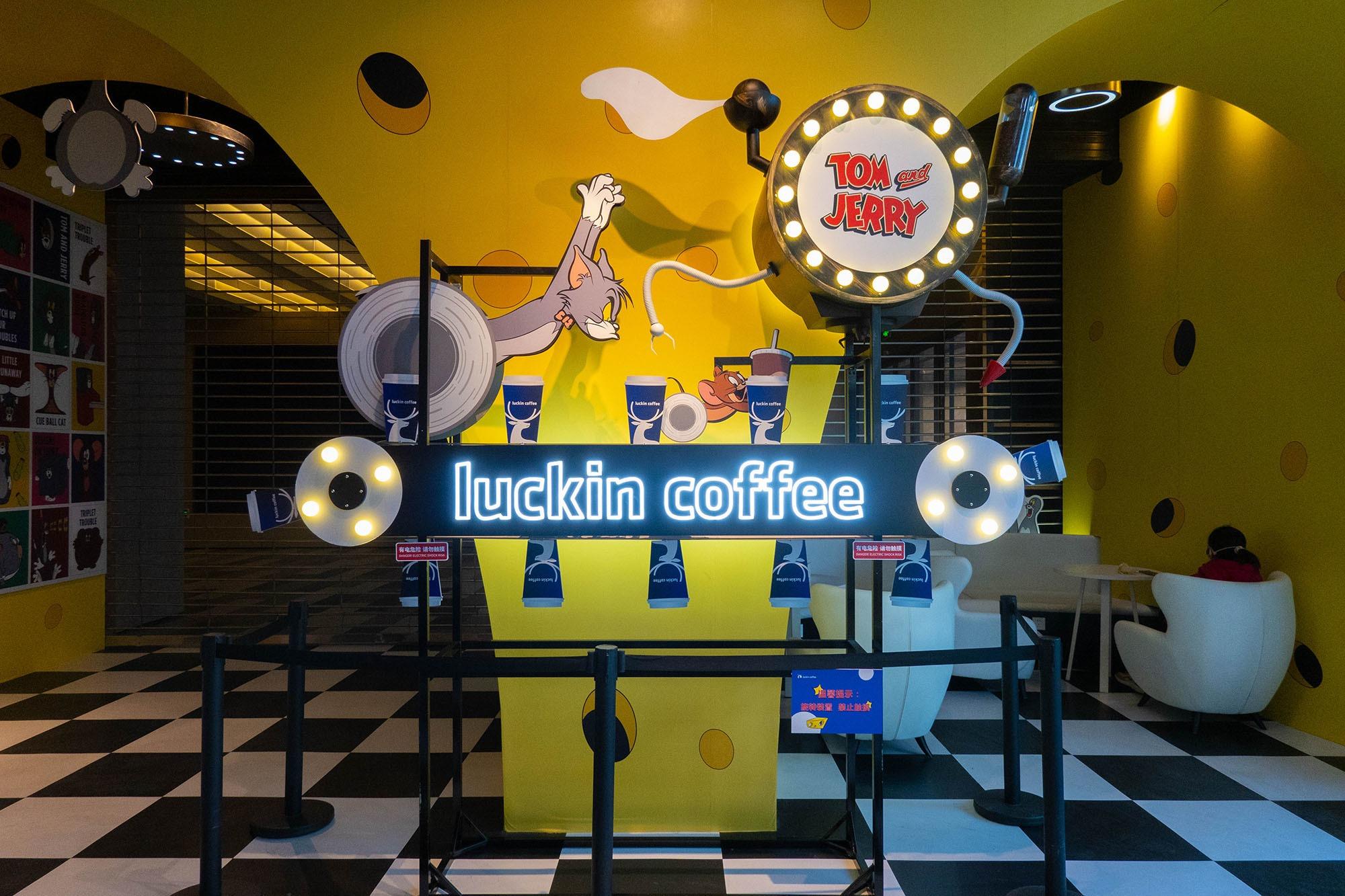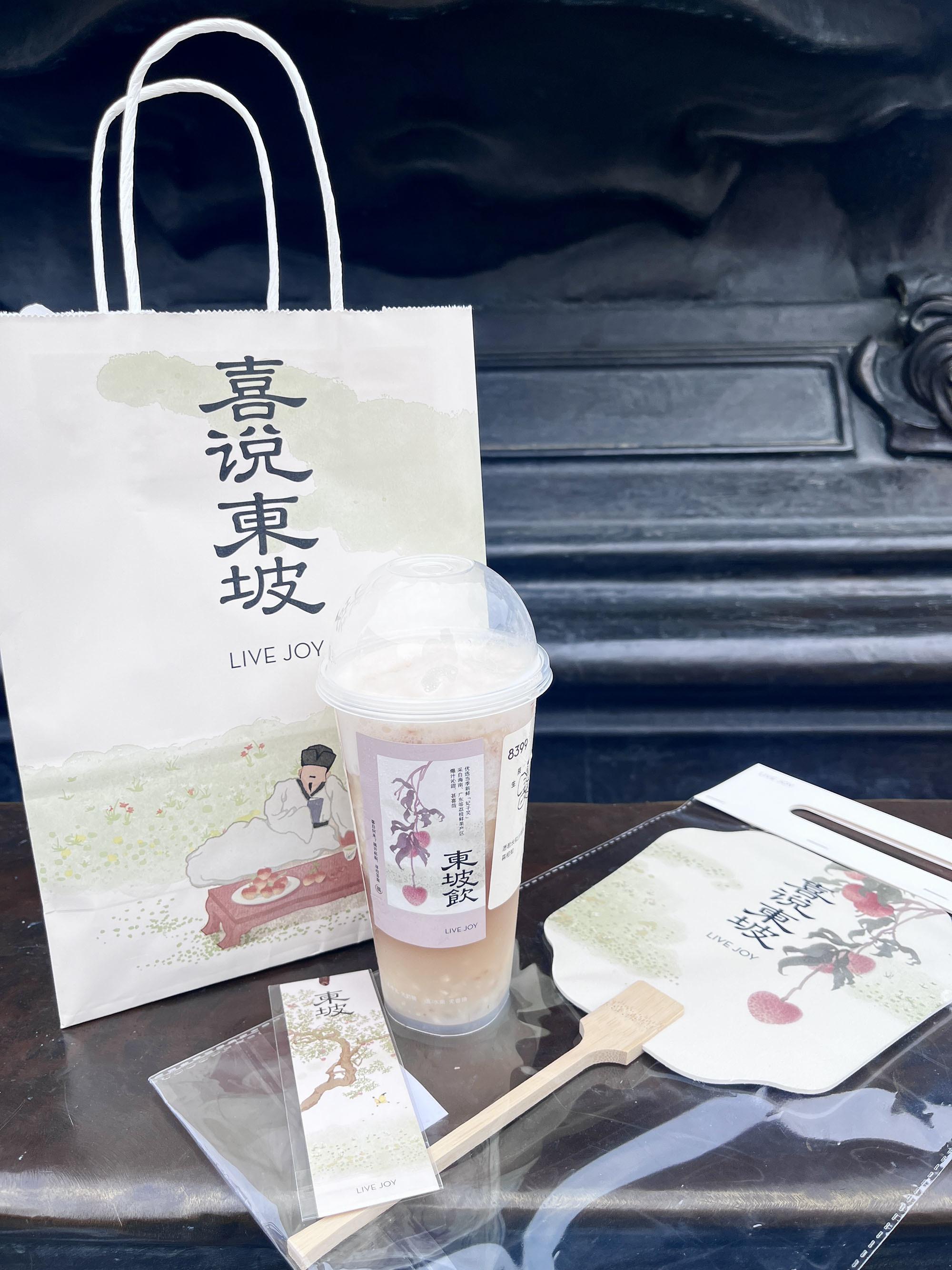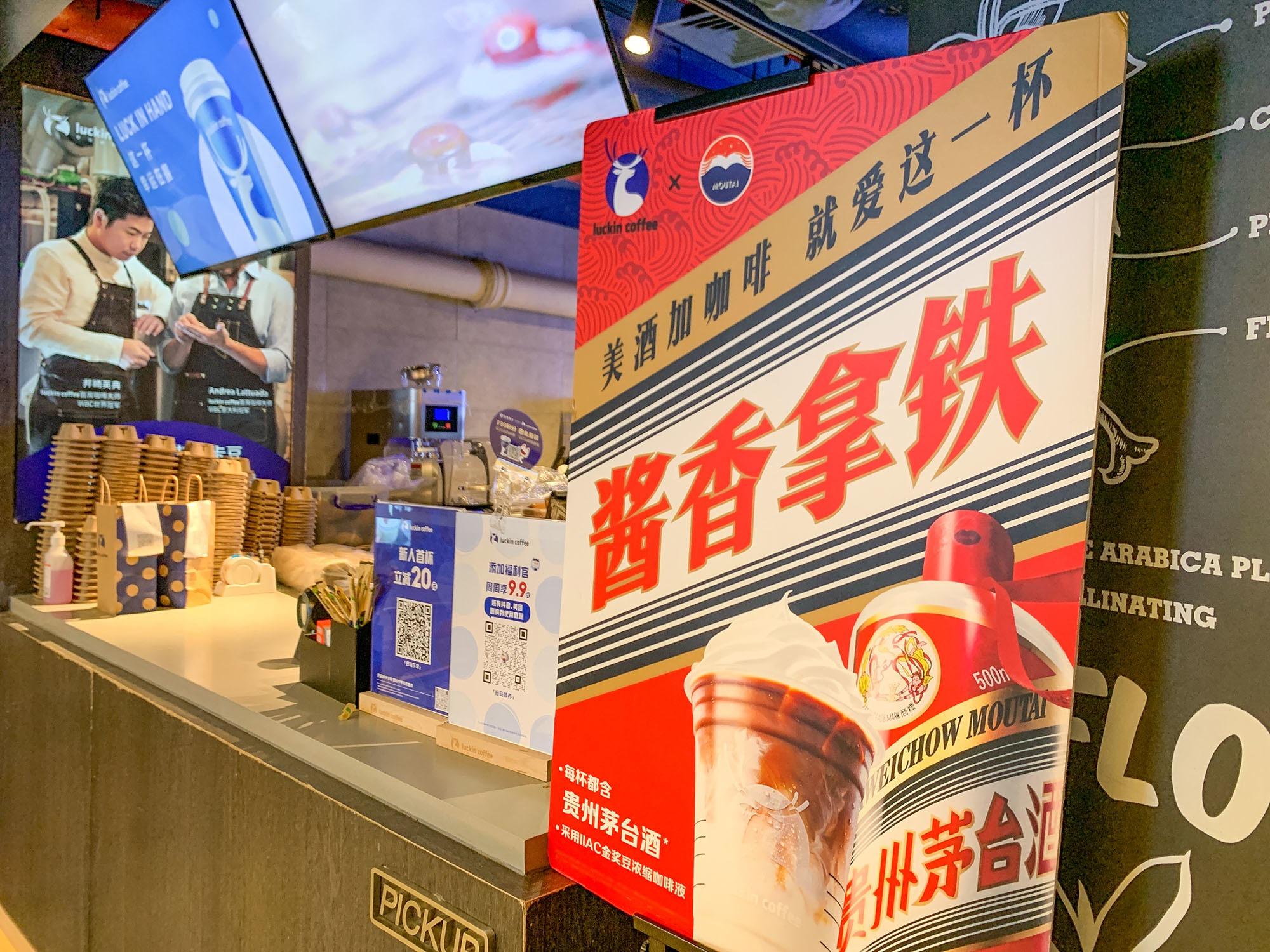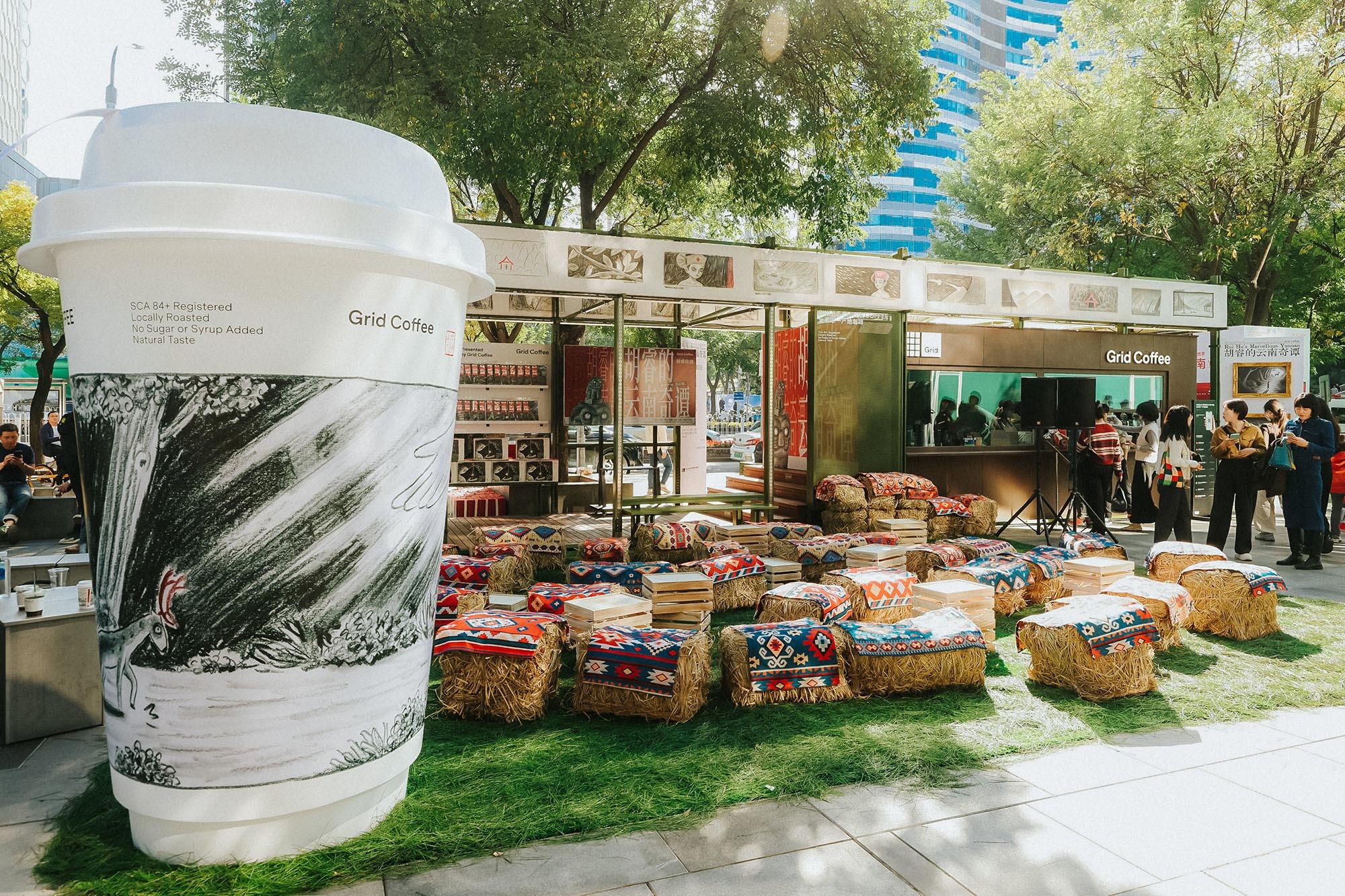Pooling of ideas achieves mutually beneficial outcomes
 A Luckin Coffee store is decorated with elements from the Tom and Jerry cartoon series. Last year, Luckin Coffee collaborated with makers of the series to introduce themed items such as cups and cup sleeves for consumers. (HE JING / FOR CHINA DAILY)
A Luckin Coffee store is decorated with elements from the Tom and Jerry cartoon series. Last year, Luckin Coffee collaborated with makers of the series to introduce themed items such as cups and cup sleeves for consumers. (HE JING / FOR CHINA DAILY)
Every time a new co-branded drink is launched, Xu Jian, the 23-year-old branch manager of a chain store selling the popular Chinese drink Heytea in Beijing's Sanlitun area, and his team, prepare for a challenging day.
The store boasts an abundance of materials for such drinks, including cups, cup sleeves and paper bags, and the 30-plus employees stand ready to help customers.
This group enjoys trying new things, actively engaging in discussions on trending topics, has a strong desire for social sharing
Chen Shenghua, author of the 2023 Beverage Brand Co-Marketing Observation Report
The store opens at 10 am, but Xu and his team start preparing for work at 8 am. By 9 am, there is already a long line waiting outside.
As the doors swing open, customers and online orders flood in. However, about an hour later, Xu takes the tough decision to close the delivery channel, as the huge number of orders for the latest co-branded drinks are overwhelming, and ensuring prompt delivery becomes a challenge.
Xu said it also takes about 40 to 50 minutes for in-store customers to receive their drinks.
"The majority of orders are for new co-branded products. Many customers also come to the store for related giveaways, repeatedly buying drinks to obtain items such as badges," he said.
On Jan 8, Heytea announced a new co-branded drinks collaboration with Hongshan Forest Zoo in Nanjing, Jiangsu province, featuring three animals from the zoo — Dudu, a white-faced saki monkey; Almond, a capybara (a type of rodent); and Jasmine, a koala.
In addition to special drinks launched with the zoo, Heytea introduced badges and fluffy bags. By lunchtime, the bags had sold out on the online platforms of many stores in Beijing.
 A specialty crafted drink introduced by Heytea. (PROVIDED TO CHINA DAILY)
A specialty crafted drink introduced by Heytea. (PROVIDED TO CHINA DAILY)
On the same day, Luckin Coffee partnered with the popular domestic animation series Xiaolan Friends to introduce co-branded stickers.
Customers received a free sticker on buying any two drinks, and each sticker came with a scratch card for the chance to win a free cup of coffee. Luckin Coffee also added co-branded emojis.
Over the past year, co-branded beverages have become increasingly popular among younger consumers in China, creating a new market for drink brands. This has led to a noticeable increase in the frequency of co-branded product launches, coupled with the diverse exploration of collaborative strategies.
Intense competition in the beverage industry triggered the fervor for joint marketing. In their quest for market share, brands have transitioned from products and supply chains to engage in an all-out commercial battle.
In October, the Hongcan Industry Research Institute, which focuses on the catering sector, released its Beverage Brand Co-Marketing Observation Report for 2023. The report predicted that the beverage market would reach 261.3 billion yuan ($36.32 billion) last year, a 22.8 percent year-on-year rise.
In the first three quarters of last year alone, 18 popular brands producing freshly made beverages collaborated 236 times. During this period, brands such as ChaPanda, Naixue, and Mixue Ice Cream & Tea doubled their joint marketing efforts compared with the whole of 2022.
Naixue, in particular, launched 33 collaborations, staging three to five joint marketing campaigns every month. Other brands, including ChaPanda, Heytea, and Luckin Coffee are also jumping on the co-branding bandwagon.
In September, as singer Jay Chou's album Fantasy marked its 22nd anniversary, Naixue teamed up with the Boohee app to launch Fantasy Milk Tea, riding on Chou's influence. This collaboration was hugely successful, with more than 1.46 million cups of the beverage sold on the first day, netting sales of over 300 million yuan.
 Moutai-flavored latte, a joint venture between Luckin Coffee and Kweichow Moutai. (PROVIDED TO CHINA DAILY)
Moutai-flavored latte, a joint venture between Luckin Coffee and Kweichow Moutai. (PROVIDED TO CHINA DAILY)
Young audience
Researcher Chen Shenghua, who authored the marketing report, said there are two main types of beverage co-branding — collaborating with another brand, or teaming up with intellectual property.
IP collaborations have become popular, as they offer a broad audience, significant influence, strong customer loyalty, deep emotional connections, and easy complementary effects, Chen said.
The target audience for beverage co-marketing is primarily the 18-30 age group, especially Generation Z consumers (those born in the late 1990s or early 2000s), he said.
"This group enjoys trying new things, actively engaging in discussions on trending topics, has a strong desire for social sharing, and possesses robust purchasing power, influence and creativity. It also closely follows trends in movies, games and other popular fields," Chen added.
Heytea and Luckin Coffee emerged as top players in the competitive field of co-marketing last year.
Moutai-flavored latte, a joint venture between Luckin Coffee and China's leading liquor maker Kweichow Moutai, grabbed the beverage co-marketing limelight. Launched in September, the product proved an outstanding success, with more than 5.42 million cups sold on the first day and daily sales revenue exceeding 1 billion yuan.
Chen attributes the product's success to two key factors. First, it triggered category innovation by combining coffee and Moutai liquor. Second, in terms of marketing, it broke through social barriers, increased the visibility of Moutai, and precision-targeted young consumers seeking fresh, creative flavors, and social experiences.
Last summer, Heytea collaborated with luxury brand Fendi to introduce the specially crafted Fendi Joyful Yellow drink. The launch trended on Sina Weibo for seven hours and more than 1.5 million cups of the drink were sold in just three days, setting records for Heytea's first-week sales of a new product. The color yellow also quickly became a fashion trendsetter last year.
 Grid Coffee, a chain focusing on single-origin coffee, stages an exhibition featuring coffee from Yunnan province at Beijing's Sanyuanli market in October. (PROVIDED TO CHINA DAILY)
Grid Coffee, a chain focusing on single-origin coffee, stages an exhibition featuring coffee from Yunnan province at Beijing's Sanyuanli market in October. (PROVIDED TO CHINA DAILY)
Chen views this success as a chance to expand the creative possibilities for cross-industry marketing in the beverage sector, adding that Fendi's influence elevated the Heytea brand image.
Xu, the Sanlitun branch manager, has been with Heytea for three years, starting as a store employee and working his way up to become a beverage mixologist. He became manager of the outlet in April.
Last year was particularly busy for Xu, with Heytea collaborating on several co-branded beverages with different brands and IPs.
One collaboration that stood out for him was with the action role-playing game Genshin Impact. One day, a group of teenagers visited the store, spending the entire time passionately explaining each character in the game to customers ordering the co-branded products.
"Before launching such a product, we undergo training to ensure all staff members are familiar with the brand or IP, making it easier to introduce to customers. These students volunteered to provide explanations because they love Genshin Impact," Xu said.
After the initial collaboration between Heytea and the makers of Genshin Impact in September 2022, the two partnered again in August last year.
On the day co-branded products featuring the 2.0 version of Genshin Impact were launched, several Heytea stores experienced overwhelming demand. Nearly 3 million cups of co-branded beverages were sold in three days, with the highest daily sales at a single store exceeding 3,600 cups.
Other activities initiated by both parties also received positive responses from the games community. At the Genshin Impact offline carnival, Heytea, the first tea brand to take part in the event, set up a booth. During the four-day carnival, the booth was highly popular, selling more than 5,000 cups of co-branded drinks on its busiest day.
Heytea customized the presentation of two popular characters from Genshin Impact — Gan Yu and Shen He — along with the development of beverage products and related designs.
For example, the drink named after Gan Yu draws inspiration from Gan's basic skills. It blends imported pineapple chunks with slow-fermented yogurt, resulting in a rich milky flavor with a lively pineapple twist.
 A saleswoman from Heytea displays the specially crafted Fendi Joyful Yellow drink, produced last summer in collaboration with luxury brand Fendi. (PROVIDED TO CHINA DAILY)
A saleswoman from Heytea displays the specially crafted Fendi Joyful Yellow drink, produced last summer in collaboration with luxury brand Fendi. (PROVIDED TO CHINA DAILY)
Ideas shared
Co-branded products are here to stay. Last year, Luckin Coffee collaborated with makers of the Tom and Jerry cartoon to introduce themed items such as cups and cup sleeves for consumers. On the lifestyle-focused social media platform Xiaohongshu, users share how they transform such items into pen holders, for example.
Xiaohongshu features a tag for Tom and Jerry merchandise transformations, with users sharing their creative ideas. Some turn paper bags into tissue boxes, and cups into pen holders, while others make decorative art, fridge magnets, and night lights. Users also craft bookmarks, phone cases, themed calendars, and even a Christmas tree.
One user, "Bizhi Niangaogao", shared the step-by-step process of turning stickers into fridge magnets. Using materials such as cold laminating film, soft magnets, scissors and a carving knife, she spent an afternoon transforming nearly 20 sticker designs into these magnets.
Co-branding has extended beyond being a sales competition among major labels. Beverage companies are using various methods to showcase the cultural essence behind their products to achieve mutually beneficial outcomes.
In October, an exhibition featuring coffee from Yunnan was held at Sanyuanli market in Beijing to promote four key coffee destinations in the province — Menglian, Simao, Mangshi, and Ninger.
For the event, the entire market — inside and outside — was adorned with numerous captivating hand-drawn illustrations. Visitors sampled the latest coffee from Yunnan and exchanged stamps they collected at booths for exclusive refrigerator magnets.
The event was a joint venture between Grid Coffee, a chain focusing on single-origin coffee, and the animation director Hu Rui.
Hu, director and art designer for the second episode of the highly popular series Yao-Chinese Folktales, created a short animation film for the event titled Red Deer Dance, drawing inspiration from the culture and art of the Dai ethnic group in Yunnan.
Chen Ziyu, founder of Grid Coffee, said it plans to host promotional events on the origins of coffee beans, twice a year, and the second event will always feature such beans from Yunnan.
"We're a Chinese brand, and Yunnan is an important place for coffee in China, making our connection even stronger. Our annual event not only bolsters our ties, but also brings more business and income to local coffee farmers," Chen Ziyu said.
He added that in the past, information about Yunnan coffee, such as cultivation and production methods, proved too technical for consumers to grasp. This year, the coffee has been introduced in a more collaborative manner, with the brand working with Hu to make a short film featuring stories about Yunnan to showcase the province's attractions.
"Hu Rui's style is distinctly Chinese, with an Eastern vibe. We wanted to connect with young people by using labels and keywords. As Hu's animation works have become a big deal this year, we decided to team up with him," Chen Ziyu said.
"Sanyuanli market is the perfect place to hold this event. Quality ingredients are always linked to a well-known place, so a top-notch ingredient, especially one from a specific region, is a great choice to be shown at the market."
The event not only attracted Grid Coffee's regular customers and Hu's fans, but also actively involved shoppers at the market. There was also lively participation in the exhibition on Xiaohongshu.
"In addition to showcasing coffee from Yunnan, the event produced increased foot traffic and sales for the market vendors," Chen Ziyu said.
Chen Shenghua, the researcher, views co-branding as a mutually beneficial choice for both parties, as it essentially involves an exchange of audiences.
By using each other's brand influence and resources, it enables channel expansion, mutual access to audiences, and resource sharing. This, in turn, brings together diverse audience groups, triggering traffic and ultimately boosting brand awareness and improving brand image, Chen Shenghua added.
However, last year, some co-branded products did not deliver positive marketing outcomes. For example, luxury skincare brand Helena Rubinstein's collaboration with Manner Coffee failed to attract potential customers.
Chen Shenghua said this lack of success may be due to the failure to choose the right co-branding partner, an inability to seize traffic opportunities, or the absence of distinctive features in the co-branded product.
"Some brands have not invested in product or category innovation. Rather, they have engaged in co-branding simply for the sake of it, or pursued innovation without a clear purpose," the researcher added.
Chen Shenghua predicts that this year a wider variety of co-branded products will match consumer trends such as individualism, practicality, and a laid-back lifestyle.
He said the approach to co-marketing will become more diverse, with a shift toward digital and intelligent strategies.
"For example, advanced artificial intelligence will be used in consumer goods technology for analysis and to create smart marketing plans. This also involves using smart devices to enhance human-machine interaction," he added.


